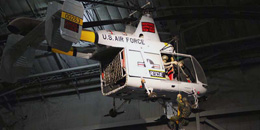| Kaman | ||||||||||||||||||||||
|
H-43 /
HTK Huskie
|
||||||||||||||||||||||
.jpg) |
||||||||||||||||||||||
|
HH-43 Photo: Robert Deering 1969 Idlewild AAF (A805) Taegu, Korea |
||||||||||||||||||||||
| The Kaman HH-43 Huskie was a helicopter with intermeshing rotors used by the United States Air Force, the United States Navy and the United States Marine Corps from the 1950s until the 1970s. It was primarily used for aircraft firefighting and rescue in the close vicinity of air bases, but was later utilized as a short range overland search and rescue aircraft during the Vietnam War. Under the U.S. Navy's pre-1962 aircraft designation system, U.S. Navy and U.S. Marine Corps versions were originally designated as the HTK, HOK or HUK, contingent upon their use as training, observation or utility aircraft. | ||||||||||||||||||||||
Design and developmentIn 1947 Anton Flettner, a former German teacher and inventor, was brought to New York in the United States as part of Operation Paperclip. He was the developer of the former German helicopter Flettner Fl 282 "Kolibri" (Hummingbird), which had the principle of the into each other combing rotors, that solved the problem with the torque compensation. Anton Flettner stayed in the United States and become the chief designer of the Kaman company. He started to design new helicopters, using the Flettner double rotor. The Huskie had an unusual inter-meshing contra-rotating twin-rotor arrangement with control effected by servo-flaps. The first prototype flew in 1947 and was adopted by the U.S. Navy with a piston-engine. In 1954 in an experiment by Kaman and the US Navy one HTK-1 was modified and flew with its piston engine replaced by two turbine engines becoming the world's first twin turbine helicopter. Later the Air Force adopted a version with one turboshaft engine: HH-43B and F versions. Operational historyThis aircraft saw use in the Vietnam War with several detachments of the Pacific Air Rescue Center, the 33d, 36th, 37th, and 38th Air Rescue Squadrons, and the 40th Aerospace Rescue and Recovery Squadron, where the aircraft was known by its call sign moniker "Pedro". During Vietnam, the two-pilot HH-43 Huskie flew more rescue missions than all other aircraft combined because of the unique hovering capability. The HH-43 was eventually replaced by newer aircraft in the early 1970s. |
||||||||||||||||||||||
|
||||||||||||||||||||||



